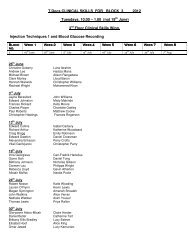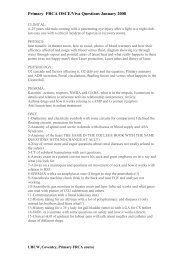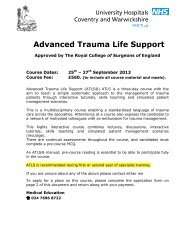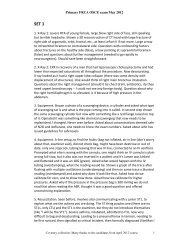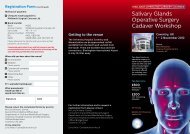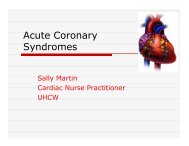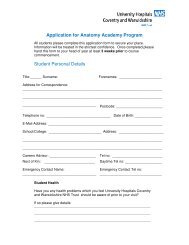Primary FRCA exam January 2010
Primary FRCA exam January 2010
Primary FRCA exam January 2010
- No tags were found...
You also want an ePaper? Increase the reach of your titles
YUMPU automatically turns print PDFs into web optimized ePapers that Google loves.
<strong>Primary</strong> <strong>FRCA</strong> <strong>exam</strong> <strong>January</strong> <strong>2010</strong>VIVAPharmacology- Opiods and opiod receptors - where they are in thebody and how they work, side effects etc- Beta Blockers - How they lower the blood pressure,different characteristics, etc- Metabolism - Phase 1 and Phase 2, differences andpurpose of metabolism, cytochrome P450Physiology- Cardiac cycle, LV pressure and volume curves- Iron metabolism - storage, heamoglobin, absorption etc- Water balance - "If you drink a litre of water whatwill happen...", osmopreceptors, ADHPhysics- Capnography, methods that can be used, differentcapnography traces- Infusion Pumps - Errors with them, safety features- Fluid flow, pressure difference across tubes, laminarand turbulent - somehow this lead onto cardiac outputmeasurement with doppler!Clinical40 year old in an RTA with a closed femoral fracture.Questions on haemorrhage, further trauma management,complications of blood transfusion, finally fat embolismintra-operativelyOSCE1 - Axillary nerve block - show position on an actor2 - Anatomy of coronary arteries3 - Communication - Consent a Jehovah's witness -discuss options other than blood products4 - Nerve injury - Stupid station - 6 different picturesof positions on the operating table that can damage thebrachial plexus and 7 different parts of the plexus thatcould be damaged - match them up. Went on to the1
<strong>Primary</strong> <strong>FRCA</strong> <strong>exam</strong> <strong>January</strong> <strong>2010</strong>consequences of radial and ulnar nerve injury.5 - Defibrillator - had to defbrillate simman who hadgone into fast AF intraoperatively6 - Checking A-line set7 - CVS <strong>exam</strong>ination8 - x-ray of neck with C2/3 fracture9 - Resus scenario - just talking through asystolicarrest10 - History taking - Man for TURP, history of chronicbronchitis11 - Simman - Desaturating due to ETT in right mainbronchus12 - Anatomy of trigeminal nerve13 - Change of tracheostomy tube14 - History taking - young woman with history ofrheumatic fever15 - History follow on station16 - x-ray - lateral chest x-ray17 - Check a Bain circuit - few questions about fresh gasflow18 - Humidity - measurement, equipment and graphsSet 2OSCEXR- upper lobe consolidationHow to insert LMA and contraindicationsHx for wisdom tooth extraction who has prev # nose and penicillin allergyPicture of Fischer Paykel hot water humidifierSeveringhaus electrodeCaudal blockAnatomy of ribs and intercostal blockComm skills - pt for arthroscopy who has URTICross section anatomy at C6Sim man- pulsed VTExamination (on sim man) CVS- ASBradycardia in recovery (talk through) (evil <strong>exam</strong>iner!)Hx for Lap Steri (IVDU and suggestive of TB)3D reconstruction of CT facial views (very random)Examine peripheral pulses and take BP and measure CVP2
<strong>Primary</strong> <strong>FRCA</strong> <strong>exam</strong> <strong>January</strong> <strong>2010</strong>US images for IJV cannulation then questions on CVP waveform (didn't want you to draw itthough)VivasPharmFactors affecting speed of onset of local anaestheticsReceptors (focused on GPCRs)Antibiotics- mainly penicillins then a bit on aminoglycosidesPhysioV:Q matching, west zones and effects of anaesthesiaCompare cardiac myocyte and pacemaker action potentialCompnents of blood then went on to ask about buffers (but other people got asked aboutimmunoglobulins)Clinical22year old with penetrating eye injury whilst drunk- discussion around sux and IOPCritical incident- anaphylaxis after RSIThen another critical incident re hypoventilation in recovery (differential diagnosis)PhysicsIsotherms for nitrous then oxygen, critical temp etcBiological potentials, amplifiers, interference, CMRR, gain etcWork, power, energy, force etcSet 3Pharmacology SOE1. Name some classes of intravenous induction agent. Discuss the structure of thiopentoneand how it contributes to its action. Tell me about methohexitone (....aaargh!). Compare thepharmacokinetics of Thiopentone with Propofol.2. Pharmacokinetics. Tell me about steady state. What factors influence steady state. Contextsensitive half life.3. DigoxinPhysiology SOE1. CO2 dissociation curve, carriage, haldane effect. ODC.2. Receptors: ion-channel linked, kinase-linked, G-protein linked, intracellular. Examples.3. Stress response (focussed on neuroendocrine response).Clinical SOE54yo elective hernia repair, obese, HTN-How would you assess this patient pre-operatively-What are the risks?3
<strong>Primary</strong> <strong>FRCA</strong> <strong>exam</strong> <strong>January</strong> <strong>2010</strong>-Critical incident: high spinal - tube, cancel the surgery, go to ITU (was what they wanted tohear!)Physics SOE1. Blood pressure measurement (focussed on non-invasive)2. Lasers3. Fibreoptic scopeOSCE1. Humidification (wet/dry bulb hydrometer: MoA, definitions, dangers ofoverhumidification)2. Central line: internal jugular anatomy and landmarks, discuss technique and complications3. Electrical safety. Symbols. Circuit diagram, asked to comment on (difficult station!)4. Communication skills. Needle phobia, consent for sickle screen.5. Resus 1: tracheostomy change6. Resus 2: obstetric emergency: local anaesthetic toxicity7. Spinal cord anatomy8. History: TAH (fibroids), anaemia, previous PE/PONV9. History: Lap chole, GORD, FHx sux apnoea10. Cranial nerves III-XII11. CXR - inhalation of foreign body12. C-spine - patient for appendicectomy, looked like Ank Spond, questions about heart blockand aortic regurgitation13. Giving set/Flow: flow rates through various cannulae, how to improve flow etc.14. Airway anatomy/difficult intubation: how to improve a Grade III view, laryngeal nervesupply, methods to detected oesophageal intubation15. SVT16. Capnography (abnormal traces, calibration)17. Ankle block: distribution of nerve supply, demonstrated on modelSet 4Phys/pharmCO2 dissociation curveStress response to surgeryReceptors and neuromuscular transmissionPhysics/ clinicalNon invasive BP measurement- how does DINAMAP work?Picture of Bronchoscope- what parts, how does it work? How do you clean it?Safety and Lasers4
<strong>Primary</strong> <strong>FRCA</strong> <strong>exam</strong> <strong>January</strong> <strong>2010</strong>OSCECaudal blockAnatomy C6 levelBroad complex tachy and defibAnatomy of thorax and ribsHumidificationCO2 electrodeChest drains- what the different bits are forBradycardia and managementSet 5SOE Pharmacology/PhysiologyPHARM1)IV Inductions agents, list what we use, structure of thio and differences between oxy andthio barbiturates, keto/enol transformation, side effects of thio,2)Pharmacokinetics of IV infusions, time to reach steady state, distribution half lives, contextsensitive half times, talked about remi Vs propofol3)Digoxin, mechanism of action, negative chronotropy vs positive ionotropy, uses in AFib,narrow therapeutic index ED50:LD50, treatment of overdosePHYS1)CO2 carriage in the blood, draw the graph (everyone else got given the graph to label, I hadto draw but did it VERY badly), draw the red cell, carbamino compounds, haldane effect andchloride shift2)Surgical stress response, neuroendocrine, hypothalamo-pituitary axis, glucagons andinsulin, nitrogen balance3)Neuromuscular junction, Ach nicotinic receptor, draw it, other receptors, G protein with<strong>exam</strong>ples of each type, intracellular steroid receptors, how they work, gene regulationSOE Clinical/PhysicsCLINICAL54 year old obese man with hypertension on diuretics for inguinal hernia repair. BP165/105mmHg on admission. Night before operation. Called to ward by nurse because of BP.5
<strong>Primary</strong> <strong>FRCA</strong> <strong>exam</strong> <strong>January</strong> <strong>2010</strong>1)What is obesity, BMI, Problems with obesity, physiological, cardio, resp, GI, metabolic,type 2 dm causing gastric stasis, what is OSA and why is it a problem, post op with opiatesetc2)would you take this BP at face value? No, need to repeat, check cuff size etc. BP now150/90. Would you anaesthetise? Probably, not set rules RE BP and this may represent goodcontrol for him3)How would you anaesthetise, wanted spinal, then short of breath on table DD of this highspinal, cardiac and resp causes. Causes of high spinal excess volume, excess dose AND put intoo high!Then gets really short of breath so end up having to tube, where would you send him after?When would you wake up? Wanted a specific time frame I said when cardiovasc stable andcontrolled environment I said 6 hours.PHYSICS1)Non-invasive BP measurement, how they work, what is measured and what is derived, howto calculate MAP, cuff sizes, when are they inaccurate, what complications can they cause,wanted petechial haems, nerve damage, poor blood supply to distal extremities, pressuresores2)Fibreoptic bronchoscope, what is it used for, why do ENT surgeons use them pre-op,wanted things like airway swelling in burns, epiglottitis etc, showed a picture, what each partwas (pointed to them for me), how is it cleaned and sterilised, what methods of sterilisationdo you know3)Lasers, what precautions are taken in theatre, why, what does laser stand for and how doesit work, showed a picture of a lasing medium and asked how it produces the beam, where islaser surgery used in hospital medicine, wanted general surgery/ENT and ophthalmologyOSCE1)History taking watched by an <strong>exam</strong>iner. Lady for lap chole. Cousin with anaestheticproblem ?what. nothing else particularly different. Quite straight forward.2)Resus sim man. Patient on ICU with perc trache done 48 hrs ago known to be a difficultintubation. Tracheostomy just fallen out. Sats low 70s. Cant put trache back in. Can ventilatewith guedel and mask only when nurse puts finger over trache hole! Cant intubate cant seeanything. LM A didn’t work for me. Sats never came above 70 but not sure if they weremeant to. One person got sats of 95%! Help is coming.3)Radiology Cxray. 2y old child SOB from a party. Complete whiteout left lung. 10 T/Fquestions some wereLeft haemothoraxLeft collapseAnaphylaxisInhaled foreign body6
<strong>Primary</strong> <strong>FRCA</strong> <strong>exam</strong> <strong>January</strong> <strong>2010</strong>Heimlich manoeuvre dangerousBronchoscopy indicatedChest drain indicated4)Cross section of spinal cord. Very hard. Knew id got some wrong as told later what theywere! Whats blood supply to the cord. Where does ant spinal artery arise. What happens inant spinal artery occlusion.5)Given grade 3 layngoscopy picture. How could you improve the view. Clinical ways toknow of oesophageal intubation NOT capnography. Capnography traces from bain/circle andrebeathing.6) and 7)History from 42 y old with menorrhagia for TAH. Had previous GA as a child. AlsoGA Csection with post op DVT and PE 12 yrs ago. Also had migraines and took aspirinPRN. Taking iron tablets. Smoker. Cap to front tooth. No allergies. On the follow on stationwas asked why she was having TAH and menorrhagia was not the answer! So i don’t knowbecause she told me it was for heavy periods. Also asked what else she did for migraines???8)IV cannulae and maximal rates of flow. Differences between pink and grey. Not the colour.Wanted 4 differences. IV giving sets how to improve the flow.can you entrain air through thegiving port?9)Humidity. Different pictures of humifiers. What can achieve 100% humidity in the trachea.What is humidity absolute/relative.10)IJ cannulation landmark technique. Seldinger technique. Angle you go inat.complications. post op care i.e., chest xray.11)ankle block. Anantomy of nerves. How to block each nerve and doses of LA.course ofsaphenous nerve in the leg.12)cranial nerve <strong>exam</strong> excluding optic nerve.nothing difficult here13)electricity (very hard!!) picture of patient attached to lots of monitoring in theatre andquestions about equipotential earths and mains frequency etc I just didn’t understand really.Then asked to pick 2 electrical symbols from about 30 on a laminated sheet and say whatthey were which was fine.14)Resus SIMman. Obstetric PEA arrest. Just had epidural top up now unresponsive. DDhigh spinal and IV LA. Was IV LA. ALS algorithm then asked questions on intralipid. Alsowhat else can be given???15)SVT management. Rhythm strip given of SVT. Drugs. Vagal manoeuvres. Joules used forcardioversion and how many times.then what other drugs?? I had already said amiodarone soIm not sure if this is what she wanted again?16)capnography. How does it work. What clinical info does it give you (3 things). Signs ofcardiac arrest, disconnection, COPD. Very straightforward.17)radiology. Lateral C spine. Think it was ank spond. 10 TF questionsAll cervical intervertebral disc spaces visible (C7 T1 was there so I said yes)Obvious osteophyte formationSigns of fusionCricoid pressure may fracture this neck7
<strong>Primary</strong> <strong>FRCA</strong> <strong>exam</strong> <strong>January</strong> <strong>2010</strong>Patient will have severely restricted mouth openingPatient may have aortic regurgRare complication is cardiac conducting defectsPatient will have preserved VCPatient likely to have chest wall involvementSet 6Pharmacology:Tell me about isoflurane.Tell me specifically about its effect on CVS.Compare CVS effects with sevo, halothane, desflurane.Tell me about routes of administration. What factors make it desirable to administer drugs byS/L and transdermal routes? What drugs can be given by these routes?Tell me about heparin. How does it work? Unfractionated vs LMWH.Physiology:Tell me about West's zones. Blood flow in each area.Tell me about PVR. What factors affect it?Tell me about temperature control and how body responds to low temperatures. Neuralpathways etc.Tell me about a nerve cell membrane and what property allows conduction of electricalactivity. Nernst potential & Goldman-Field.Physics:What factors determine flow in a cannula? What are the desirable properties of an arterialcannula & why? Pictures of art lines, IV lines, Tuohy, Stimuplex. Describe features. Quinckevs pencilpoint for SAB. French gauge & SWG.Defib - circuit, features. Factors influencing charge on capacitor. Factors influencingdischarge.CPEX. What is it? How does it work? What does it measure? What info does it give?Clinical:37yr old lady with bad Crohn's, on steroids, sulphasalazine, azathioprine. Needs pan-8
<strong>Primary</strong> <strong>FRCA</strong> <strong>exam</strong> <strong>January</strong> <strong>2010</strong>proctocolectomy. Has had diarrhoea, abdo pain, pyrexia. What would your plan be forpreparation, anaesthesia & post-op? Epidural stops working - what do you do? Stops peeing -what do you do? Pre-renal/renal/post-renal etc.SET 7PharmacologyLocal anaesthetics- Structures including drawing- Factors affecting speed of onset/potency/duration/venoconstriction- Whether LA useful in infected tissue- Henderson Hasselbach equationPenicillins- Structure- Mechanism of action- Spectrum of cover- Resistance mechanisms- Synergism with gentamicinSorry can’t remember the 3 rd topic!PhysiologyFunctions of the blood- Components and proportions- Clotting cascade- Red blood cells- Hb structure, cooperativity etcVQ- Definitions- Diagram- FRC- Factors affecting VQ9
<strong>Primary</strong> <strong>FRCA</strong> <strong>exam</strong> <strong>January</strong> <strong>2010</strong>Cardiac action potentials- Pacemaker vs ventricular AP’sPhysicsGas laws- Cylinder pressures- Bourdon gauge- Measuring contents of N20/O2 etcBiological potentials- Compare and contrast ECG/EEG/EMG- Black box concept- Common mode rejectionLots of definitions – Force etc and their applications to anaesthesiaClinical22 yr old man who had sustained a penetrating eye injury outside a nightclub- Pre-op assessment- Method of induction- Critical incident – anaphylaxis- Then discussed a pt in recover who has resp depression and possible causes andhow to approach managementOSCE1. C6 transverse anatomy2. Facial CT reconstruction – Frontal and maxillary fractures.3. History station – young male for wisdom tooth extraction. Day case. Livesalone and had driven to the hospital. Allergies.4. Questions about 35. Humidifiers – why used, different types and problems associated with them6. Severinghaus electrode – labelling parts (very odd diagram!) and talking aboutthe mechanism. Other methods of CO2 analysis7. Demonstrate a caudal, calculate safe LA doses, mx of LA toxicity and it’srecognition10
<strong>Primary</strong> <strong>FRCA</strong> <strong>exam</strong> <strong>January</strong> <strong>2010</strong>8. Rib anatomy – 1 st rib and a thoracic rib. Demonstrate where subclavian a, v,& brachial plexus cross. Neurovasc bundle. To demonstrate how you woulddo a IC block. On a real person, show site of carina, needle decompression &IC chest drain insertion9. Peripheral arterial and venous <strong>exam</strong>ination, BP,10. Sim man – Broad complex tachycardia with pulse. Compromised thereforedefib. Amiodarone.11. Rhythm strip – sinus brady – management, risks of asystole12. History taking (observed) – lap steri … pretty standard, not entirely sure whatI was meant to discover!13. Explaining to a patient with a URTI for a knee op that he should be postponed14. Sim man – Assess CVS system and take BP. Comment on likely diagnosisand investigations. Why regional may be inappropriate15. CXR – RUL collapse16. LMA insertion and questions about appropriatenessSet 8OSCE 11/1/101. History – 35 year old lady for lap. Sterilisation. Recent hx night sweats and weightloss.2. Simman – feel pulses, NIBP, auscultate heart – systolic murmur, questions on aorticstenosis3. Xray – postop cxr collapse RUL questions on management postop.(someone elsethought it was aspiration)4. LMA – check equipment, insert on manikin, questions about contraindications andsafety5. Anatomy – cross section of neck at C6, label diagram, route of EJV6. History taking and follow-on –young fit man for dental extraction, broken nose so onenostril patent only, allergy to penicillin, fhx anaesthetic problems7. Radiology – CT 3D reconstruction of trauma to head and face. Questions onmanagement of head injury.8. Equipment – humidifiers. Picture of hot water bath humidifiers, pros cons other typesof humidifier.9. CO2 electrode – picture with labels, ways of measuring CO2 how is it transported inthe blood.10. Caudal block in child – sacral anatomy, max dose local, show technique, what criteriafor going home.11. Communication – patient for day case op with bad cold, cough and fever. Discussplan, pt having trouble getting time off work. Didn’t shout, actually quite compliant.12. Chest drains – 2 underwater seal chest drain bottles, what are the parts, where do theyconnect, how full, what height from pt, problems with transport.13. Resus – pulsed VT but low BP, already intubated. Better after 1 shock synch.14. Exam – Assess pts pulses, BP and JVP.15. CVP line insertion – pictures of ultrasound views, questions of how deep, how toknow in correct place, where is correct place, why head down11
<strong>Primary</strong> <strong>FRCA</strong> <strong>exam</strong> <strong>January</strong> <strong>2010</strong>16. Resus – sinus brady requiring atropine, general run through of brady algorithm17. Anatomy – 1 st rib, other rib where is neurovasc bundle, where would you dointercostals block, which attachments and grooves.Set 9PRIMARY <strong>FRCA</strong> EXAM QUESTIONS JAN <strong>2010</strong>OSCE STATIONS:1. Simulation scenarios:‣ Anaphylaxis post induction‣ Can’t intubate can’t ventilate.2. Resucitation stations (Actors as patient)‣ RTA with haemothrax pt in A&E(Q about initial assessment / chestdrain insertion/GCS).‣ ITU pt on vent with tension pnemothorax(Q about <strong>exam</strong>ination andneedle insertion and definitive treatment)3. Resuscitation stations with manikin:4. Mono oral Stethoscope‣ Cardiac arrest/?AAA rupture‣ VF arrest : algorithm‣ Bag & Mask ventilation/NP airway,FRC5. Skin temp probe: define Kelvin,triple point water?,core temp?6. Laryngeal blades+ Magill’s:‣ Compare disposable blade & straight blade‣ light bulb adv/disadv over FO light‣ reasons for brady cardia with straight blade7. Anatomy trachea/Lung/Diaphragm8. Anatomy orbit9. Anatomy Laryngeal inlet10. Anaesthetic machine with modified Jackson-Rees circuit;12
<strong>Primary</strong> <strong>FRCA</strong> <strong>exam</strong> <strong>January</strong> <strong>2010</strong>‣ Q on efficiency/What happens if bag is completely torn?‣ What happens if reservoir tube length is doubled‣ Minimal gas flow in 25 kg11. Labour Epidural skill demo12. History stations:13. Dynamap.‣ Lady for Vaginal hysterectomy with significant PMH pre-eclamp/renalfailure /PPH in previous pregnancy‣ Pregnant lady with Ankylosing spondylitis‣ Diabetic /IHD pt for cataract surgery‣ 20 yr old for tonsillectomy-peanut allergy/crownSOE:Pharmacology:‣ Benzodiazepines‣ Route of adm of drugs/Bioavilability‣ Phenothiazines/antiemeticsPhysiology:‣ Cardiac pacemaker cell AP‣ What are Hormones/classification‣ ABG (resp alkalosis) analysisClinical:72 yr old with Rh Arthritis for Hemiarthroplasty hip.‣ About RA‣ CI : High spinal‣ Post-op analgesiaPhysics:‣ Transport ventilator‣ Arterial trace and CO calc‣ Draw over vaperizors13
<strong>Primary</strong> <strong>FRCA</strong> <strong>exam</strong> <strong>January</strong> <strong>2010</strong>Set 10Osces1. Needlestick injury - what to do after needle stick, incidence of getting HIV (%), incidenceof HIV if take antiretroviral medications, who to report to, who do they report to, what dothey do after. do you take consent from the victim to take his blood.2. Take BP of this lady - select the right cuff, why select that cuff, what sounds listen for(diastolic and systolic), do men and women have same BP.3. Eye - peribulbar block and how to do it on a skull, what is the sensory supply of the eye,what is the motor supply, length of eye ball. complications of peribulbar block.4. <strong>exam</strong> this mans pulse, precordium, and heart sounds. explain what you do as you do it.5. resuscitation - 24 year old lady with ectopic pregnancy in pea - steps. who do you call.6. History from lady for hysterectomy. she had an ITU experience which wasnt good before.7. History and follow on - Young IDDM for tonsillectomy. last bout of tonsillitis 2 weeksago. cant open mouth wide with tonsillitis. lots of holiday due to recurrent bouts.8. Temperature. Picture of thermistor, then graphs and which one corresponds to the picture -and the other graphs are representing what device. why do kids loose temperature quicker.how do you stop it.9. Two laryngoscope blades - straight and curved. one plastic and one metal. advantages ofplastic. pressor response to laryngoscopy and why get bradycardia sometimes. what nerveresponsible. The showed magills forceps - what used for.10. Resuscianni - what head position for ventilation. give the manikin 5 breaths.disadvantages of nasopharygeal airway.11. Resuscitation - MH.12. Picture of stethescope and earpeice (hearing aid) attached to it. what used for. advantages.for kids or adults. when use it. what respiratory and cvs sounds can you hear with it that youwant to.13.14.15.16.17.Physiology/ Pharmacology viva- ODC. draw it and mark on points. what shifts it to left/ right. why is this useful. howmeasure oxygen content blood.- calcium - use in body. why get tetany and explain it in terms of calcium.- muscarinic receptors in body. where, what type. draw receptor. what acts on it. namemuscarinic agonist.- colloids - what are they. why use.14
<strong>Primary</strong> <strong>FRCA</strong> <strong>exam</strong> <strong>January</strong> <strong>2010</strong>Physics/ Clinical- clinical was 24 year old 38 weeks pregnant with severe fetal bradycardia. management -catagory of c section. explain anaesthetic technique. is regional CI. say you anaesthetise -then CICV. mx.physics - what is a vacuum. where do we use them. draw scavenging system. explain whyhigh flow low pressure. where is low flow high pressure used in anaesthetics. draw a graph oftemperature decline with anaesthetised patient. what do we do to stop decline. how efficientis it.Set11Physics- Mapleson circuits, efficiency during controlled and SV and why this is the case (inspiration,expiration, expiratory pauses etc.)- Oxygen measurement - different types, explain in detail galvanic fuel cell electrodeincluding equations at both anode and cathode, explain the mechanism of paramagneticanalyzer- Symbols on anaesthetic equipment. Very small print stuff - symbols for manufacture date,symbol for expiry date, symbols for different types of sterilisation. Didn't know a single oneof them but the <strong>exam</strong>iner was very patient and guided me through (e.g. what does this looklike? an egg timer, oh it's probably expiry date then)ClinicalYoung motorcycle RTC victim, compound tib fib no other injuries but may be hepatitispositive.- First question mostly regarding preop assessment and how you would anaesthetise him- Second question - develops high airway pressures and hypotensiobn. Differentials.Treatment of anaphylaxis- Third question - talk me through what you would do following a needlestick injury fromthis patientPharmacology- Draw a dose response curve, semi log plot, definitions of agonists and antagonists and theirdose response curves- Volatiles - compare sevo and des in terms of physical properties and how this affects theiraction- Drugs acting on platelet function - I asked and was allowed to eat up some time bydescribing steps in platelet plug formation. Spoke about aspirin and NSAIDs. I couldn't recallhow clopidogrel worked and couldn't recall a name for a GIIb/IIIa inhibitor (tirofiban waswhat I was after).15
<strong>Primary</strong> <strong>FRCA</strong> <strong>exam</strong> <strong>January</strong> <strong>2010</strong>Physiology- What is an enzyme, Michaelis Menten kinetics, which enzyme systems are we interested inas anaesthetists, talk about acetylcholinesterase and pharmacogenetic variability- Physiology of ascent to altitude, control of respiration, alveolar gas equation- Pressure volume loops in the left ventricle in minute detail, demonstrating stroke volume,myocardial work, changes in contractility, changes in afterloadOSCE13. Anatomy - spinal cord - LA volumes to block one level in epidural, total CSF volume,name the tracts on the diagram (which confusingly had ascending and descending all on thesame side rather than how it is normally illustrated). Which tracts do which, blood supply tocord, affect of anterior artery ischaemia.14 History taking - woman for TAH. Elicited hx of awareness during GA section, traumaticgas induction plus all the usual bits including a cap on tooth.15 Follow on station - questions I couldnt answer there: what is the patients Hb on the bloodtest GP did, when was the patient's PE which she didn't have the courtesy to disclose16 C-spine X-ray from patient with history of severe arthritis. Looked arthritic. Questionsincluding is the patients FVC likely to be reduced, is mouth opening likely to be impaired, dothey need an echo to rule out AR.17 Fluid flow. Appalling station, absolutely godawful. Given a pink venflon and a greyvenflon - name 4 differences (not including the coloured cap), what is the flow rate for each.Shown a blood giving set - what happens to flow when diameter doubled, why doesn't itactually achieve this 16x increase. What is the ball valve in the giving set for. What fluid isused to calibrate flow rates in venflons (???)18 Hazards - humidity - absolute vs relative, identify types of hygrometer from pcitures. Whyis the wet thermometer at lower temperature. How is humidity read from a wet and dry bulbhygrometer. What is humidity maintained at in theatre, two reasons why this is beneficial.Name 3 types of humidifier that allow 100% humidification in a breathing circuit.1 Technical. CVP insertion. Landmarks for IJ, contents of sheath, talk through the procedurewith equipment on table, post procedure management, 5 common or serious complications2 Anatomy/ technical - ankle block on an actor. Nerves supplying ankle joint, how would youblock deep peroneal and tibial. Describe course of saphenous nerve. Point out area suppliedby saphenous, area supplied by tibial3. Examination - cranial nerves III-XII inc Rinne and Weber tests4 Communication station - young man for elective arthroscopy. Afro-Carribean and refusingsickle cell testing as needle phobic.5 Resus - called to labour suite after SHO has given 20mls marcain down epidural. Ptarrested, PEA on monitor. Got BLS started, wedged, called for help. Practical side stoppedthen asked questions - what are two most likely causes (total spinal, intravenous), what wouldyou do now that BLS has been started (doses of adrenaline and atropine, when they are16
<strong>Primary</strong> <strong>FRCA</strong> <strong>exam</strong> <strong>January</strong> <strong>2010</strong>repeated, doses of intralipid, need for section). All straightforward - other candidates said that<strong>exam</strong>iner didn't hide his disappointment well when they didn't know the dose of intralipid,apparnetly asked one if he'd every administered local anaesthetics!)6 Hazards - electrical safety showing very confusing diagram of patient connected to CVPline and ECG monitoring, types of earth, differences in earth potentials. Really hard to followwhat was wanted. Finished with a grid of about 20 symbols and asked to pick two and namethem.7 Equpiment - capnography - information provided, what happens at each stage in acapnograph trace, causes of abnormal traces8 Critical incident - managing a narrow complex tachycardia, doses of adenosine, action ifadenosine fails, energy used for cardioversion, doses of adrenaline,9 History taking - patient for interval lap chole.10 Resus - recently inserted trache falls out on AICU, nurse bagging without O2. difficult tobag, better with two person technique, sats not improving markedly, reinsertion fails, unableto intubate from top. Options now.11 Radiology - Child sudden breathless at birthday paty. X ray shows almost completewhiteout on left with mediastinal shift to left (i.e. collapse). Straightforward questions thetheme being is it aspiration or foreign body and collapse12 Difficult intubation - identify this laryngoscopic grade, techniques to improve it, clinicaland objective signs of oesophageal vs tracheal intubation. Identify 3 capnograph traces fromchoice of 4 - oseophageal intubation, tracheal intubation in a Bain and in a circle.Set 12SOE Pharmacology and physiologyPharmacology1. Antibiotics; Fluclocaxillin and other penicillins difference and indications for use, movedonto gentamicin with reference to indications for use and therapeutic index and finished upwith antibiotic resistance and penicillinsReceptors- classification and types and moved on to g protein coupled receptorsLocal anaesthetics- what affects speed of onset of local anaesthetics pka, lipid solubility andprotein binding, moved onto pKa of lignocaine, bupivicaine and toxicity and treatment andIVRa and why prilocaine is used.PhysiologyShunt and V/q mismatch and V/q ratio of upper lung to lower lung west zones and howanaesthesia affects V/QComponents of blood and the pH of blood, HB WCC platelets - speaking to other candidatesthey moved on to buffers which I did not17
<strong>Primary</strong> <strong>FRCA</strong> <strong>exam</strong> <strong>January</strong> <strong>2010</strong>Action potentials- cardiac VS pacemaker potentials, differences and why, things that affectthe pacemaker cell potential and whyPhysicsCylinders and the differences between oxygen and nitrous cylinder and why is thisIsotherms and N20Biological potentialsECG interference and Common mode rejection, amplifiers and gainClinical22 year old male post penetrating eye injury, was standing outside a night club and howwould you assess this patient- ABCDE trauma could he have drugs as well as alcohol onboardwhat other investigations would you request and how would you anaesthetise this patient- i.eRSI but Sux would increase IOP, what else could you do to reduce IOP?Turned into critical incident about anaphylaxis but what other differentials could there behow would you manage this situationAnother clinical incident about some one desaturating post op and opioids and residualNeuromuscular blockadeOSCE stations:Electrical Hazards- symbols safety and earthCommunication station- sickle cell anaemia and needle phobiaLandmark technique for Internal jugular vein cannulationAnkle block nerves and areas supplied as well as veins that run with the nervesHistory taking - TAH menorrhagia, reduced haemoglobin and migrainesFluids and giving set - cannula sizes and how could you increase the speed of the infusionSVT ECG and managementCapnography traces and principlesPregnant lady - cardiac arrest post epidural top upHistory taking lap chole with RefluxCritical incident tracy fallen out COPD with difficult intubationX rays- collapse lung after inhaled foreign body in a childC spine x ray in arthriticSpinal cord anatomy and tractsAirway mallampati scoring and Laryngoscopy grades and what could you do to improve theview in a difficult intubationHumidification - definitions measurement and typesExamination of cranial nerves 3-12Set 13<strong>Primary</strong> Viva Jan <strong>2010</strong>18
<strong>Primary</strong> <strong>FRCA</strong> <strong>exam</strong> <strong>January</strong> <strong>2010</strong>Pharmacology1) Tell me how NSAIDS work?Drew diagram of pathway. Effects. Uses. Side effects. Why does aspirin’s antiplateleteffect last 7 days?2) What are Ach receptors? What types. Where are they found.?Discussed nicotinic Ach Rs in the autonomic ganglia and NMJ, and muscarinic Ach Rsin the PNS. How do they work (Ligand gated ion channels/ GPCRs). Different ligands- egatropine. Ipratropium. Uses and effects.3) What are the characteristics of the ideal colloid? Colloids vs crystalloids. Starches vsgelatins.Physiology1) Given a drawing of the Oxygen dissociation curve. Mark on 3 points- arterial blood(with normal pKa range), mixed venous blood and p50. What is the purpose of thep50 value. What causes right shift? Had to calculate O2 content of blood and O2delivery. What is huffners constant? To calculate dissolved O2 in blood, why do wemultiply PaO2 by 0.0225? What happens to O2 content at altitude? What happens inhyperbaric situation eg 10m below sea level.2) What is the role of Ca2+ in the body? How is it regulated? Vitamin, PTH3) How is blood pressure controlled? What is the body’s response to losing 15%circulating volume bloodClinical scenario25 year old primigravida 39/40. Sudden foetal distress. Had not required epidural up untilthen. Discussed management options. How would I anaesthetise this pt for emergencyLSCS. Physiological changes in pregnancy/special considerations. Critical incident:difficult intubation. Sats drop afterwards- possible causes. Management of aspiration.Physics19
<strong>Primary</strong> <strong>FRCA</strong> <strong>exam</strong> <strong>January</strong> <strong>2010</strong>1) What is suction/Vacuum? What are the features of medical suction? What pressures?What flow rates? (vs scavenging) How is the vacuum created? What are thecomplications of suctioning?2) Types of heat loss under anaesthesia. Ways of minimising heat loss by radiation.What are the 3 phases of heat loss during a 3 hr operation? (I didn’t know this- graphof temp vs time)3) Dead space- what is it? Fowlers method. Derive the Bohr equation.<strong>Primary</strong> <strong>FRCA</strong> OSCE 13 th <strong>January</strong> <strong>2010</strong>1) Equipment: shown a monoauricular stethoscope- what is this? Uses.2) Base of skull anatomy (name foramen) and orbit anatomy- discuss peri bulbar eyeblock. Whats special about the needle. Complications.3) History station. See elderly obese with obstructive sleep apnoea man in preopassessement who wants hernia repair next week as day case. You need to advise himto stay in overnight- he gets angry. Concerned about leaving his wife alone.4) Resus SIM MAN- called to A and E. Lady with ectopic pregnancy- unresponsive.BLS- ALS. PEA arrest- lead scenario.5) History station- See a 39 yo lady pre op assessment for hysterectomy.6) Examination- <strong>exam</strong>ine a patient’s cardiovascular system. Peripheral pulses.Praecordium- ?aortic stenosis7) Resus- talk through. Cardiac arrest on medical ward. Shown a rhythm strip with fineVF. ALS8) Theatre SIM MAN. Fit well young man just been given drugs for RSI forappendicectomy. Drugs given, you walk in and take over. Anaphalaxis- CICVscenario (swollen tongue- unable to open mouth). Desaturates- emergency needlecricothyrotomy.9) Xray station- CXR ?coarctation- rib notching10) Talk through anatomy of thorax, hilum, diaphragm11) Paeds- 2 yo to bag-mask ventilate. Optimum positioning.12) Xray- barium swallow with pharyngeal pouch. Management13) History with follow on station- young man type 1 diabetes pre tonsillectomy.14) Equipment: plastic MacCoy blade vs metal straight blade. Innervation of larynx15) Equipment: Axillary thermometer. How does it work? Name graphs (resistance vstime) for platinum resistance wire, thermocouple and thermistor.20
<strong>Primary</strong> <strong>FRCA</strong> <strong>exam</strong> <strong>January</strong> <strong>2010</strong>16) BP measurement- actually measure BP using sphyg. Cuff size. What is MAP? Whathappens to BP as get older. Male vs female.Set14PharmacologyNeuromuscular blockerso Structure of vecuroniumo Structure of the nAChR and vecuronium binding siteo Compare and contrast vec and roco Why is roc faster acting?o What are the non-NMJ actions of rocuroniumStatisticso How do we design a study?o What types of error do you know?o How do we minimise the risk of type I errors?o How do we calculate power?Vasodilatorso Pt in theatre has a BP of 230/120. What would you do?o Draw a table of drugs the reduce BPo How do beta-blockers work?o What alpha-blocker do you know?PhysiologyClinicalPreoxygenationo What are the physiological principles of preoxygenation?o How does [N2] change in the lungs?o Draw the oxyhaemaglobin dissociation curveo What is the blood content of oxygen?o How can we increase the oxygen content?Autonomic nervous systemo Compare and contrast the sympathetic and parasympathetic nervous system(anatomy, chemistry, functions)Capillary dynamicso What properties of blood determine flow?o Describe the movement of fluid across the capilliary wallo What are the functions of lymph?21
<strong>Primary</strong> <strong>FRCA</strong> <strong>exam</strong> <strong>January</strong> <strong>2010</strong>You are asked to anaesthetise a 13yo afro-caribean male who presented with a painfultesticle.o Lots of discussion about sickle cell – his Hb is 11 when you ask for it.o How do you test for sickle cell disease?o Anaesthetic management for RSIo Particular focus on pain management• Post-op analgesia regime including drug doses• Regional anaesthesiaCritical incident: severe laryngospasm on extubationPhysicsHumidificationo Humidity definitionso Measuring relative and absolute humidity, concentrating on wet and dry bulbhygrometer and its limitationso Methods of humidification in anaesthesiaPressureo Definitions of force and pressureo Measuring atmospheric pressureo Torricellian vacuumMonitoringo What are the AAGBI standards?o How would you detect disconnection?o Awareness – who’s at risk, prevention22
<strong>Primary</strong> <strong>FRCA</strong> <strong>exam</strong> <strong>January</strong> <strong>2010</strong>OSCEMONITORINGo Assemble this Bain circuito Talk about <strong>exam</strong>ples of EtCO2 traces, eg obstructed, rebreathingALSo Pt with stable VT in recovery – focus on managemento VT is refractory to amiodarone and cardioversion – what do you do?HISTORYo Pregnant patient with ankylosing spondyllitis.SimMano AnaphylaxisEQUIMENT AND PROCEDURESo Epidural technique, landmarks, LA dose, epidural adrenaline doseANATOMYo Spinal cord blood supply, spinal tracts + functions, CSF volume, CSF specificgravityRADIOLOGYo CXR – sarcoidosis (probably....!)o Steroid replacementHISTORY + FOLLOW ONo Elderly woman for phaeco with angina and diabeteso End organ damage in diabetesEQUIPMENTo Mapleson F – test the circuit – the reservoir bag had a leako What are the minimum gas flows for 20kg kid if spontaneously / mechanicallyventilating.o What is the maximum weight for use?RADIOLOGYo Cardiomegaly and PPMo Questoions about PPM modes and implication for anaesthesiaEQUIPMENTo DYNAMAPo Graph of cuff pressure vs oscillations. How are sBP, MAP and dBPcalculated?COMMUNICATIONo Explain MH to this trainee ODP, who saw a case today and felt out of hisdepth. What can he do to help in a crisis?EXAMINATION / PROCEDURE23
<strong>Primary</strong> <strong>FRCA</strong> <strong>exam</strong> <strong>January</strong> <strong>2010</strong>o Diagnosis of tension pneumothorax and insertion of needle thoracostomy andICD.o Complications of ICD insertionEXAMINATION AND MANAGEMENTo ATLS scenarioo Pt has a haemothorax and is hypovalaemicANATOMYo Structure, muscles and innervations of the larynxCRITICAL INCIDENTo Lead a VF arresto Perform BLS correctlyo Defibrillate safelyo ALS drug dosesSet 15Viva -Physiology - 1. ABG trace with pH 7.0, pCO2 1.3 kPa, pO217 kPa - questions were about dignosis and compensationincluding role of CSF, chemoreceptors in compensation. 2.effects of 1000 ml NS infusion rapidly. 3. CSF -formation, absorption and differences with plasma. Monroe-Kelly doctrine and questions on ICP.Pharmacology - 1. LA- mechanism of action, pKa, lipidsolubility and protein binding principles and d/d betweenester and amide and then lignocaine and bupivacaine. 2.Liver in drug metabolism- phase 1 & 2 reactions and<strong>exam</strong>ples of each of them with details of P450. 3.Pharmacogenetics - sux apnoea, MH.Physics - 1.freezing point, boiling point, SVP andcolligative property. 2. N2O SVP and cylinder pressure,latent heat of evaporation, fusion, specific heat. 3 temptime graph, differences between laminar and turbulantflow, Hagen- Poisell. equation, reynold's no. Zeroeing &calibration, 2point & 3 point calibration & application.Damping & resonance.Clinical - 68 year old insulin dependent DM for emergencybelow knee amputation, temp 38.5, BM 27 mmols. DM and itscomplications, GA, regional advantages & disadvantages,pain relief, Post-op seizures in recovery, d/d & mx.OSCE -1. Diagram showing ECG leads, CVP line and questions on24
<strong>Primary</strong> <strong>FRCA</strong> <strong>exam</strong> <strong>January</strong> <strong>2010</strong>leakage current, potentials, equipotential and identifytwo from the diagram.2. Ankle block - all five nerves and their supply indetails.3. IV canuula - d/d between 16 & 20 gauge and d/d betweenIV and arterial cannula. Giving set, fature flow rate andfuntion of 3-way tap.4.Sim man- dislodgement of tracheostomy tube andmanagement.5. Resuscitation- Cardiac arrest in pregnant patient, LAtoxicity and dose of intralipid.6.Equipment - Humidity and identification of hair, dry&wet & Regnault's Hygrometers.7. Capnograph traces and questions.8.IJV cannulation.9.History taking - For Hysterectomy.10. History follow-on- For elective Lap-cholecystectomy.11.Communication- Afro-Caribbean for Blood test for Sicklecell disease.12.ECG - Narrow complex tachycardia, SVT.13. X-ray -a. Collapse lung, b.14.Section of spinal cord- different tracts(very confusingdiagram, all tracts on one side).15.endotracheal intubation- Diagram showing Cormack-Lclassification 3.16.Set 16PharmacologyClassify induction agentsDraw barbituric acidWhat are the different physicochemical properties of thiopentone andpropofol?What classes of drugs affect gut motility?What are the differences between metoclpramide and domperidone anddroperidol?Draw a concentration time curve for an IV drugWhat is meant by bioavailability?How can we relate clearance, Vd and T1/2?PhysiologyWhat is the body's response to 500ml blood loss?Can you draw a nerve action potential?Why are there gaps in the myelin sheath?25
<strong>Primary</strong> <strong>FRCA</strong> <strong>exam</strong> <strong>January</strong> <strong>2010</strong>What determines the resting membrane potential?How does the kidney produce a concentrated urine?Explain the countercurrent mutiplier mechanismClinical6 year old girl for squint surgery. What would you like to discusswith the mother?Critical incident: MH and its managementPhysicsPick one from 6 logarithmic graphs. What is its equation? Give aclinical <strong>exam</strong>ple?How can you work out the exact angle between the x axis and a straightline?What is a time constant? What is a rate constant?How do vaporisers work?How is a desflurane vaporiser different?OSCESacral anatomy and caudal epidural talk-throughPre-op history from a really miserable womanHistory of young man due for wisdom tooth extraction and follow-onstation with an <strong>exam</strong>inerSim-Man: patient on table with VT and BP
<strong>Primary</strong> <strong>FRCA</strong> <strong>exam</strong> <strong>January</strong> <strong>2010</strong>arthroscopy. Unwilling to have op postponed. Convince him!PHARMACOLOGY:They started all the vivas gently but they got harder asthe 15 minutes went on and the pace was really fast so ifyou said you didnt know something they moved on. I didfeel that the questions were repeated rather than asked ina different way.1. They asked me to talk about the mechanism of action ofNSAID. They wanted the pathways drawn from arachidonicacid and all the end products and enzymes involved.What is the difference between COX1 and COX2 when do theyact?Why do we want selective inhibitors? What problems werefound in their use?What does each product of the COX reaction so and where?Asked about types of prostaglandins and the side effectsof their production being inhibited.2. Cholinergic receptors and their agonists. Whatmuscarinic receptor types exist and where are theypresent? What agonists do you know? What antagonists doyou know? When are they used in anaesthesia? Whateffects do they have? we talked about teritary andquaternary structures and the BBB.Otheres were asked to draw the muscarinic receptor. Iwas asked about organophosphates and then briefly abouttheir action and effects.3. Colloids, what are they and what types exist and whyare they useful? Which ones are in my hospital and whattypes they are. I was then asked to compare gelatincolloids from starch colloids. Where and how each aremetabolised. Why do colloids stay in the intravascularspace. What happens when they are infused. Describe theideal colloid or intravenous fluid. What are the sideefffects or complications of their use.27
<strong>Primary</strong> <strong>FRCA</strong> <strong>exam</strong> <strong>January</strong> <strong>2010</strong>PHYSIOLOGY1. Draw the oxygen haemoglobin dissociation curve. Whyis it that shape? What is the significance of the 50%,75% and 100% saturation points? What is the oxygen contentof blood? What the value per 100ml of blood for venousand arterial blood and they expected me to do a bit ofmental arithmetic from the equation to work it out, butin the heat of the viva I found that quite difficult andhe was happy with the normal values written in theequation and as a result. What would happen in altitudeand draw this on the graph.2. Tell me about BP response. We discussed baroreceptorsand the Renin angiotensin aldosterone system. I describedthe process with high and low BP and the effects. Heasked where the hormones were produced. What would happenin I litre of saline was rapidly infused. What is theBainbridge reflex and why does BP sometimes go up andsometimes down with tachycardia?We also talked about osmoreceptors and hypothalamus. Hewas very encouraging and corrected little mistakes egmissing out the factor of 10 in the oxygen contentequation or mentioning the bainbridge reflex. When I saidI did not know he said thats fine and moved on.3. Tell me about calcium. He let me talk and appearedsatisfied with the direction it was going. He asked whyit was important and where present and how controlled.Which organs and which hormones are important and what aretheir effect. What happens when you hyperventilate? Whydoes tetany occur? We talked about alkalosis causingincreased unionized calcium and making the cells moreexcitable and that alkalosis causes increased in thebinding affinity to albumin.CLINICALWe all started together in a room and were given alaminated sheet with a description of a case. A 25 yearold primigravida 39/40 fit and well with severe fetaldistress. Prolonged bradycardia on CTG. What do you do?28
<strong>Primary</strong> <strong>FRCA</strong> <strong>exam</strong> <strong>January</strong> <strong>2010</strong>He seemed uninterested and huffed and puffed a bit andwas frustrated when I skirted around any issues by sayingI would discuss with a senior anaesthetist in repsonse tosome of his question yet still gave me a good mark at theend!He wanted a description of each category of section andwhen I was not clear enough made me clarify what thedifference was between 2 and 3. I said I would discusswith tsurgeon but that this was a category 1 section andtherefore would need a RSI. He wanted to know whatequipment I would need and then what clinical changesoccur in pregnancy eg difficult intubation. What is theincidence of difficult intubation in the pregnantpopulation compared to non pregnant and why I thought thismay be. What I could do about this and differentlarynogscope blades and handles. He wanted percentageswhen discussing changes eg FRC and blood volumes. Wediscussed aortocaval compression and left sided tilt andas I took a while to remember this he hinted and was finewhen I mentioned it.When the RSI occurred it is was a grade 4 view and hewanted to know what I would do. We went throught the DASand he then basically wanted me to make a decision whetherto wake the patient up or continue.PHYSICS1. What is dead space? How can it be measured and Iexplained and drew Fowlers method/ graph and then theywanted me to derive the Bohr equation. Why is itimportant in clinical practice.2. Define a vacuum? Why is it important in clinicalpractice? What is the difference between suction andscavenging? What are the components? They wanted valuestoo. Could I draw the components?3. Heat loss in theatre. what is important. they showed mea diagram of a person lying on a table with arrows forradiation, conduction, evaporation and respiration andconvection.29
<strong>Primary</strong> <strong>FRCA</strong> <strong>exam</strong> <strong>January</strong> <strong>2010</strong>What percentages do they contribute to overall heat loss.What can be done to prevent each loss? what ishypothermia? Why is it problematic? Warming methods.OSCE1. Anatomy of the larynx. yes/ no and true/ false ofdiagrams I had not seen but were similar to the A-Zpictures. muscles, nerve, blood supply and lymph drainage2. Resuscitation station ALS algorithm and shock patietns3. history taking for elective CS4. critical incident anaphylaxis on sim man.5. put together a coaxial D circuit and name. How long isit and the diameters of the tubing. how to check it6. epidural technique on mannequin and LOR and thencalculate adrenaline and lignocaine doses and how to makeup solutions. anatomy of epidural space7. histoy taking an then questions on this. Diabetic.8. Diathermy frequency and recognition of diagrams egblending.9. tension pneumothorax and management and placement ofchest drain.10. cross section of spinal cord and description of tractsand their function.11. dinamap, what is the principle. what values arecalculated and which are measured and what they wouldcorrelate with on their diagram of oscillations12. X ray station of PCP13. X ray station of sail sign14. X ray staion of C spine fracture15. Mapleson F circuit check would I use it? small hole inballoon. what is the minimum FGF for 3 year old?16. explain to trainee ODP about Malignant hyperthermiaand treatment and what they should know.My questions for the OSCE were: (and apologies for scantydetails, it all goes by in such a flash):1) 2 chest drains differently filled - complications ofoverfilling, how far should the tube go into the water,30
<strong>Primary</strong> <strong>FRCA</strong> <strong>exam</strong> <strong>January</strong> <strong>2010</strong>how far below the pt, if lifted what would happen - I saidit would flow back into pt but they seemed to want more??2) 2 photos of neck as if looking through US probe -?side, ?vessels, ?causes of increased/decreased size ofvessels or intrathoracic/cerebral volume.3) Explained to pt unwell with fever decisions re electivearthroscopy - I went down line of not in best interests,but identified that he would lose his job soon if couldn'tgo to work. Said could consider WCC/CXR and if ok considerproceeding under spinal as long as pt acknowledged riskand discussed with consultant/surgeon.4) Simman - feel pulse, manual BP, auscultate heart,identify AS, describe implications.5) Hx for lap chole.6) Hot water bath picture - asked what %relative humidityit would provide, advantages and disadvantages, few moredetails.7&8) Hx for wisdom teeth & follow on - general things infit young man but lost points as didn't know his job, hehad had previous GAs with no probs but his sister ahd hada reaction which I didn't have time to go into and theywanted more details on despite him being a bit evasive?Last question they wanted to know what could obstruct hisairway after? I just listed stuff and clearly wasn'tsaying what she wanted - I wonder if it was throat pack??I had said bld, foreign bodies, collpased airway etc etc.9) 2x xrays - one looked ok?? One generally abit shadowy,nothing obvious. Details were that pt was post-op forcolitis and had lower than normal sats during ob but wasnow fine. Asked if he should have antibiotics and whetherhe had aspirated but there was nothing in the history tosay there was any periop problems so I just guessed thatit was some CXR finding that happens with people withcolitis and answered accordingly, no idea.10) 3D facial #'s - questions whether should go straightto neuro unit, is ICP 'invaluable', what #'s they were - Ithink it was through one of the orbits.11) Fake sacrum - question re anatomy, how to go aboutcaudal block & demonstrate, how far to go into space.12) Pick size of LMA for mannikin, demonstrate insertion,balloon, hom many mls it needs etc. Talk about31
<strong>Primary</strong> <strong>FRCA</strong> <strong>exam</strong> <strong>January</strong> <strong>2010</strong>complications other than pregnancy/full stomach.13) 2 pictures - pick one that can we use to measuregases. I picked what I recognised as the CO2 electrode(speaking to someone after he thought one was CO2electrode and the other was all O2, CO2 and pH as part ofABG machine so both were ok as long as you could answerquestions on whichever you chose). Question: what does the2 electrodes with the electrolyte in between form? Whatother methods can we use to measure CO2?14) Pick 1st rib out of selection on table, answer 1st ribanatomy but they asked about all the bits that are not thelabelled bits in my book. Also anatomy of it and where youwould find bifurc of trachea and aorta on an actor on thebed and some other related question that I can't remember.15) Simman - pt on table by your junior colleague, walkin, pt goes into VT - compromised, they seemed to want usto ignore A&B, went straight for DC cardioversion and hestabilised, then reassessed. What tests would you doafter?16) Bradycardia post op - many questions on causes,management, wanted adrenaline infusion with doses.17) Asked to <strong>exam</strong>ine periph pulses on an actor then domanual BP, asked about Korotkoffs sounds and which to takeas diastolic BP.18) ? - sorry.Vivas:Pharmacology:Asked how NDMRs work.Isomers: was fairly standard other than they wanted me totalk more about thio in that context.Anti-emetics: again was ok but wanted to know more aboutwhere each receptor was and about their crossover ie.cyclizine being H1 and muscarinic antagonist.Physiology:Starlings forces/CO/add L atrium trace and aortic trace toLV trace on cardiac cycle.32
<strong>Primary</strong> <strong>FRCA</strong> <strong>exam</strong> <strong>January</strong> <strong>2010</strong>Control of UO - I started with kidney itself, talked aboutADH & other hormones.Buffers - what is one? How can we classify - I talkedabout open & closed systems, we then talked aboutdifferent ones and so they suggested that I reclassifywhat I said into intracellular & extracellular based onwhat I said. Finally they moved onto 'what are buffertitration curves' and I think we may have been headingtowards drawing one but I was saved by the bell.<strong>FRCA</strong> <strong>Primary</strong> OSCE/VIVA Exam Sitting <strong>January</strong> <strong>2010</strong>VIVAPharmacology:Comapare cardiovascular effects of isoflurane and enfluraneHeparinsTransdermal drugsPhysiology:V/Q and West ZonesCell membrane structure, membrane potentials, Nernst Equation, transportmechanisms.Pulmonary vascular resistanceClinical:Inflammatory bowel patient with current illness for panproctocolectomy.o Discussion re: anaesthetic considerations, RSI, steroids (role), analgesia,immunosuppressant medications.o Epidural – assessment, management, top-up.o IV resuscitation post-op.Physics:Different needles33
<strong>Primary</strong> <strong>FRCA</strong> <strong>exam</strong> <strong>January</strong> <strong>2010</strong>o 16g Tuohyo 14g intravenous needle (discussion french gauge vs wire gauge)o 20g abocath (discussion re damping etc.)o Peripheral nerve stimulatorCPEX testingDefibrillator34
<strong>Primary</strong> <strong>FRCA</strong> <strong>exam</strong> <strong>January</strong> <strong>2010</strong>OSCE1. Technical Skills 1a. Trauma patienti. Discussion re: surgical chest drain insertion2. Anatomy 1a. Larynx3. Communicationa. Explain malignant hyperthermia to a trainee ODP4. Anaesthetic Hazardsa. Electrical safetyi. In operating theatreii. Diathermy5. Physical Exama. Head injury patienti. reduced GCS patientii. Haemothorax6. Interactive Resuscitation 1a. Defibrilation and ALS algorithmi. Safe defibrillation of patient7. Monitoring Equipmenta. Capngraphyi. Side stream bain circuit8. Resuscitation Skills 2a. Tachyarrythmia algorithm9. History-takinga. Communication skills – history takingi. Ank spondii. Previous difficult airway + PONV10. Simulationa. SIMMANi. Anaphylaxis11. Radiology 1a. CXR – Cystic fibrosis12. Technical skills 2a. Epidurali. Insertion, Safe practice, Analgesia13. Anatomy 2a. Anatomyi. Spinal cord anatomy (Asc + desc tracts)ii. Cord lesions14. Radiology 2a. CXR – indwelling pacemaker15. Anaesthetic equipment35
<strong>Primary</strong> <strong>FRCA</strong> <strong>exam</strong> <strong>January</strong> <strong>2010</strong>a. Mapelson Fi. Check system and identify problem16. Measurementa. DINAMAPi. BP measurement, Calculated vs observed readings, Cuff sizingNot included in mark scheme:17. Hx from patienta. Eye operationi. Local anaesthetic optionsii. CVS/RS co-morbidities18. Report history taking to ConsultantPhysics:Asked all sorts of facts about cylinders, what is therange of sizes, the colours of all the different gases,the volume of cylinders of different sizes containing thisgas/that gas and the pressures etc etc. Otherdistinguising features. I only knew abit about nitrous andoxygen in size E and they wanted much more than this.Pressure: wanted all different units of measurement andwhat they all are when equivalent to 1 bar. What is aNewton, how could it be calculated from cubic metres etc??Cardiac output monitoring: just got started and classifiedinto invasive/semi-invasive/non-invasive and we ran out oftime.Clinical:Given paragraph about 15yr old with known asthma, needingappendicectomy, questions relating to optimisation,questions need to ask and why. Difficulty ventilatingperi-op, differentials, what to do? Thought i was ok butthey looked very quizzical when I said that we could givenebulised salb via the catheter mount which is somethingI'd just read so I don't know why and I also mentioned IVso? Then we moved onto management of anaphylaxis.36
<strong>Primary</strong> <strong>FRCA</strong> <strong>exam</strong> <strong>January</strong> <strong>2010</strong>37




